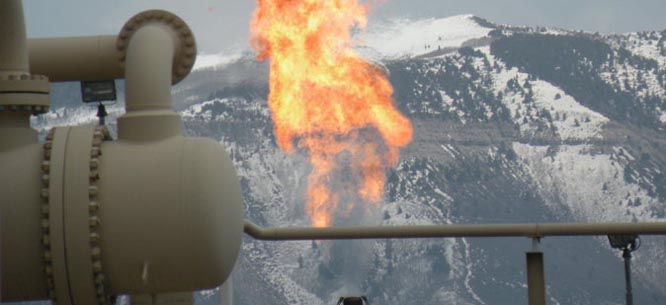Unnatural Gas: How Government Made Fracking Profitable (and Left Renewables Behind)
Unnatural Gas: How Government Made Fracking Profitable (and Left Renewables Behind)

In his much-anticipated speech on climate change, President Obama proposed smart, modest policies that would help decrease greenhouse gas emissions through support for renewable energy development and increased energy efficiency measures, prepare the country for the climate change that is already occurring, and lead international climate efforts, including phasing out fossil fuel subsides and stopping funding for new coal plants overseas. While he stopped short of proposing anything groundbreaking, such as a carbon tax, the measures would be an improvement over the current climate stalemate.
Yet the president’s continued embrace of natural gas development threatens to counteract any of his proposed climate initiatives. In the speech, Obama continuously mentioned that we are the leading producer of natural gas and proposed advancing production of oil and gas in the Bakken formation (a rock formation beneath parts of Montana, North Dakota, and Canada)—code words for expanding hydraulic fracturing, or fracking, operations. Unfortunately, fracking is not the energy panacea its supporters claim it is. The environmentally destructive nature of the process negates any net greenhouse gas benefit from natural gas. Estimates of the amount of available gas that can be tapped economically widely vary, as highlighted in Timothy Mitchell’s article in Dissent. And while fracking may release deposits of oil and gas that were previously unavailable, there will ultimately still come a time when the finite fossil fuel resources run out.
Moreover, it is only after decades of development and government support that fracking operations are now seen as cost-effective. In contrast, the support for developing renewables has been erratic and only a fraction of that given to fossil fuel industries. Renewable energy sources are often dismissed as expensive and incapable of meeting the country’s energy demands. Yet looking at the history of energy development, it is clear that political and corporate interests deliberately impeded the development and expansion of renewable energy. Fracking is a clear example of how direct government research and consistent support turned an impractical, expensive process into one that is now seen as the key to domestic energy independence.
The Role of Federal Support in Fracking
Oil and gas companies are extremely profitable and have been for several decades. Yet much of their current success was the result of not just favorable tax incentives and subsidies but also direct federal research. Federal energy subsidies began in 1916 and focused almost exclusively on increasing the production of domestic oil and gas until the 1970s. Over the following three decades, the Department of Energy invested roughly $137 million in direct gas research, in addition to federal tax credits for drillers that totaled $10 billion between 1980 and 2002.
Natural gas did not become a popular fuel until the 1950s because home use of natural gas required a large pipeline network for delivery, which was prohibitively expensive. Improvements in metal, welding techniques, and pipe making developed during the Second World War made pipeline construction more economically feasible, and throughout the 1950s and ’60s an extensive pipeline network was built. After the network was built, natural gas became more popular and inexpensive.
Hydraulic fracturing is different from regular natural gas recovery production. It requires far more water, sand, and lubricants, as well as much higher pressures than traditional oil and gas recovery methods, in order to literally fracture geological formations to release pockets of gas. While examples of hydraulic fracturing date back to the 1940s, modern-day fracking was not developed until federal research and demonstration efforts in the 1960s and ’70s helped private industry develop technologies that moved drilling past shale to tap limestone gas deposits. Earlier federal efforts to fracture shale formations and release gas did not immediately result in commercially viable technologies, but these efforts showed that diffused gas from shale formations could be recovered—something the private sector had not been able to establish. Continued federal demonstrations set technology development on a path that, with continued federal support, private interests were able to perfect.
The case of fracking shows why direct federal support and research is important: private interests do not invest in time-consuming, uncertain research because the benefits are too far out and the risks and costs are too high. Federal research agendas, on the other hand, do not have the same restrictions and need for immediate results. Without the imperfect technology development, there can be no perfected process. Federal research provided the platform and time needed to make the mistakes in developing fracking processes that the private sector could learn from and further refine.
In addition to direct federal support and incentives, regulatory provisions have rarely hampered oil and gas production, particularly fracking. While the modern oil industry was born in the beginning of the 1900s, the industry did not face meaningful regulations or oversight until the Santa Barbara oil spill in 1969. After the spill, Congress tightened regulations on leases and made offshore operators liable for spill cleanup, but for nearly seventy years the industry was able to operate and expand with little to no regulatory oversight.
Private interests do not invest in time-consuming, uncertain research because the benefits are too far out and the risks and costs are too high. Federal research agendas, on the other hand, do not have the same restrictions and need for immediate results.
In the case of fracking, regulatory exemption allowed the industry to grow as rapidly as it has. In 2003, President Bush and Vice-President Cheney backed a sweeping national energy bill that exempted hydraulic fracking from EPA drinking water regulations, despite the large volume of water used in fracking and the proximity of fracking operations to drinking water supplies. In 2005, fracking was exempted from the Clean Water Act, and in that same year states started seeing oil and gas booms. These exemptions do not mean that fracking is safe—in fact, the opposite is likely true. They do show how the regulatory system can contribute to industry development, despite serious health and environmental consequences.
Do the Investments Pay Off?
Natural gas has been a divisive issue for environmentalists. Before the problems with fracking came to light, natural gas was pushed by many environmental groups as a bridge fuel to move beyond coal. Indeed, once out of the ground, natural gas does burn more cleanly than coal and produces far fewer carbon emissions than coal or petroleum. With the expansion of fracking operations, advocates argued that there was a potential 100-year supply of gas that could be used to move toward domestic energy independence and provide a time cushion for a transition to a renewable energy future.
However, fracking is not our energy savior. For one, the process still needs refining and the amount of methane that leaks from fracking operations nearly negates any carbon benefit to natural gas. The process is also extremely water intensive and uses a chemical concoction whose specific make-up companies are not required to disclose for proprietary reasons. The result is that fracking communities across the country are suffering from mysterious health consequences and water supplies are being contaminated due to improper disposal of fracking fluids.
On top of the environmental and health consequences, the supply of natural gas is vastly overstated. The Energy Information Administration dropped its estimation of shale gas resources by 40 percent from 2011 to 2012. The Marcellus Shale, one of the largest deposits in the country, is estimated to have only a six-year supply of gas. Further, recent reports have shown that fracking is not as cost-effective as once thought. The vast majority of fracking wells deplete within five years and production has been on a plateau since December 2011. The high decline rate of fracking wells requires continuous capital inputs—at least $42 billion per year to drill more than 7,000 wells. There may be gas trapped in the shale, but the more difficult it becomes to release it, the more expensive the process becomes.
Moreover, while many proponents claim that the large supply of gas released through fracking would make prices fall, there has been little impact on electricity prices nationwide. The recent natural gas boom created an overabundance of supply, yet electricity prices have steadily increased. Utilities do set rates in advance to protect against fuel price spikes, and the cost of delivery is increasing due to investment in electricity infrastructure. But the wholesale prices of natural gas have significantly decreased, yet no cost savings have been passed on to customers.
The Other Side of the Coin: Renewable Energy Development
In the past few years, renewable energy support has become particularly politicized. The Solyndra bankruptcy provided fodder for continuous conservative attacks against government funding of renewable energy development, and since that time any research funding has been under heavy scrutiny and opposition. Even basic, long-standing support programs, like production tax credits, have faced strong opposition and been at risk of not being renewed.
Current opposition to renewable energy support seems to be particularly vehement, but historically there has rarely been strong support for this research. Indeed, renewable energy exploration and development was contemporaneous with oil and gas discovery. The first commercial oil well was drilled in Pennsylvania in 1859. The first solar-power steam generation system for industrial machinery was developed in 1860. Ethanol was one of the best-selling chemicals until President Lincoln imposed an extremely high tax on spirits, including ethanol, to finance the war effort in 1862. After the tax, industrial and fuel ethanol disappeared for forty-five years.
In the 1970s, solar-cell technology had advanced to a point where the cost was reduced from $100 a watt to $20 per watt. At that price point, solar modules were a competitive energy source for situations where electricity was needed far from power lines, such as off-shore oil rigs that only required warning lights and horns but had no power other than toxic, short-lived batteries. Ironically, it was the major purchases of solar modules by the oil and gas industry that gave the struggling solar cell industry the capital needed to survive.
Support for renewable energy continued to grow in the 1970s, with President Carter leading a movement toward energy independence through conservation and increased domestic energy production with a strong emphasis on renewables. Solar funding, for example, increased from $77,000 in 1970 to $261 million in 1977. Famously, Carter even put solar panels on the White House.
The 1970s also saw major developments in oil and gas production. In 1970 crude oil production reached its highest level in the lower forty-eight states. A few years later, in 1973, OPEC announced an oil embargo against the United States and other targeted nations and cuts in oil production. As a result, the cost of oil skyrocketed, leading to gas shortages and rationing. In response to this crisis, the Energy Reorganization Act of 1974 split the responsibilities of the Atomic Energy Commission into the Nuclear Regulatory Commission, which would take over the regulatory aspects of nuclear energy, and the Energy Research and Development Administration (ERDA), which would eventually become the Department of Energy. The ERDA was charged with bringing together all energy research and development efforts, including solar and energy efficiency measures.
Not surprisingly, the momentum behind renewable development came to a rapid halt as soon as Ronald Reagan was elected president. Not only did he remove the solar panels atop the White House, he also gutted funding for solar development and poured billions into developing a dirty synthetic fuel that was never brought to market. This start-and-stop support hindered the renewable energy industry’s growth. It is a problem that continues today. Uncertain industry outlook scares away private investment, which in turn limits the development and expansion of renewable energy deployment.
The momentum behind renewable development came to a rapid halt as soon as Ronald Reagan was elected president. Not only did he remove the solar panels atop the White House, he also gutted funding for solar development and poured billions into developing a dirty synthetic fuel that was never brought to market.
The bias against renewable funding and support is clear. Recent analysis found that over the first fifteen years an industry receives a subsidy, nuclear energy received an average of $3.3 billion, oil and gas averaged $1.8 billion,Fto and renewables averaged less than $0.4 billion. Renewables received less than one-quarter of the support of oil and gas and less than one-eighth of the support that nuclear received during the early years of development, when strong investment can make a big difference. Yet even with this disparity, more of our energy supply now comes from renewables than from nuclear, which indicates the strength of renewables as a potential energy source.
In fact, global solar capacity grew by 74 percent between the end of 2006 and 2011. In the United States, 39 percent of new electric capacity additions in 2011 were from renewable sources, and in that same year renewables accounted for nearly 12 percent of U.S. primary energy production. Nine states now generate more than 10 percent of their electricity from non-hydro renewable energy and California continues to hit record peaks of solar energy generation. Wind and solar energy continually outperform expert predictions. Wind power generation has quadrupled between 2006 and 2010.
Renewable energy development also shows how smart, consistent government support can help an industry grow. Wind was the fastest growing source of non-hydroelectric renewable generation, partly due to a federal production tax credit. In the first few years after the production tax credit was adopted, the industry grew slowly, but after attracting more investment production rapidly expanded. Unlike tax credits for the oil and gas industry that are written into the tax code, the production tax credit must be renewed every year, leaving it vulnerable to partisan politics. When it became clear that renewing the production tax credit would be a fight, the uncertainty resulted in a nationwide slowdown in the wind industry, with investors wary of investing in a market where future federal support was not predictable.
What Is the Proper Role of Government in Developing Industry?
Despite what critics claim, tax credits and mandates for production, like renewable portfolio standards, are not unnecessary government interventions in market dynamics. On the contrary, federal resources can be leveraged to provide a stable investment outlook to attract private investment. In an emerging industry, like renewables, predictable market demand through production mandates allows a steady outlook for investment. California, for example, increased its share of renewable energy from 13 to 20 percent in just three years, in large part because its renewable energy production target is 33 percent by 2020.
On the other hand, tax credits and mandates for already established industries, like oil and gas, provide no innovation capital for future growth and only act as a profit subsidy. Oil and gas companies continually post record profits and any government assistance is not only unnecessary, it diverts resources from struggling industries that need steady support to expand. Further, fossil fuels are a finite resource; any research and development support should go toward new energy sources that can permanently replace fossil fuels, and not to draining every last bit of oil and gas from the ground.
The divergent histories of renewable energy development and fracking show that it is not the strength of the technology that predicts success. Rather, it was a deliberate government strategy to develop fracking and advance oil and gas interests over the development and expansion of renewable energy. If the same level of financial and research support was targeted toward renewable energy development, we would be free from dependence on oil, foreign and domestic, and make meaningful carbon reductions to stave off the worst effects of climate change.
We can still make the transition to an economy powered by clean energy, but that window will close soon. It won’t bee too many years until energy supply sources will be the least of our concerns.
J. Mijin Cha is a senior policy analyst at Demos.





